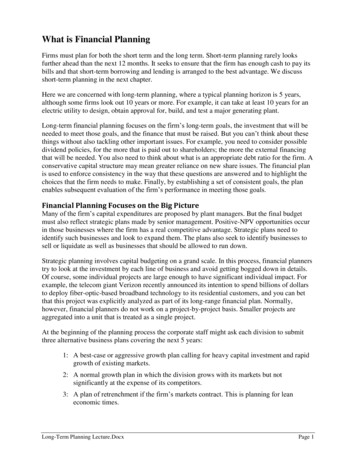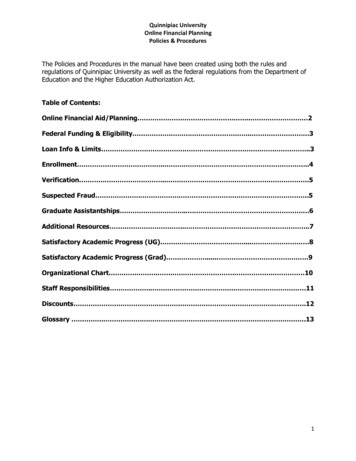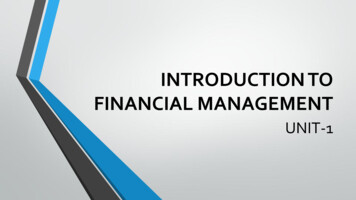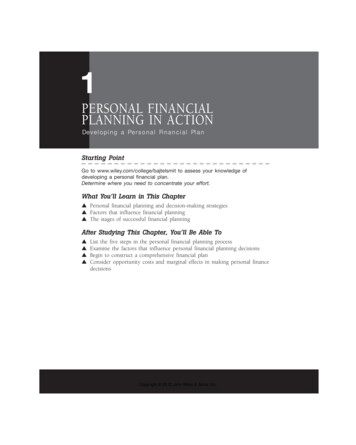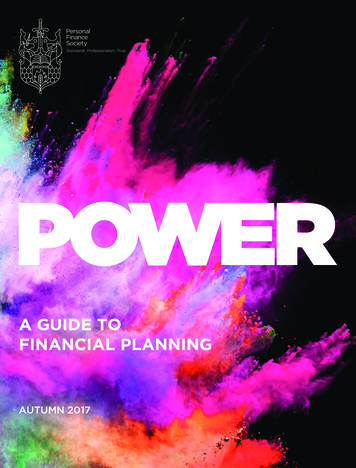
Transcription
A GUIDE TOFINANCIAL PLANNINGAUTUMN 2017
Are you a financial adviser or FinancialPlanner? You might call yourself a wealthmanager, a money planner, a financial coachor even a life planner. It’s largely a personalchoice and most of you will be comfortableexplaining your service to potential clients,who almost certainly won’t understand any ofthe subtleties that many within our market getso hung up on.Some of you will offer broad ranging adviceto a range of different client types, whilstothers will may offer specialist or niche adviceservices, such as investment, tax or later lifeplanning, to specific client types. Some ofyou will separate the advice element fromany product recommendation or execution(if appropriate). Many of you run your ownsmall firms and others will work for big firmsand have access to a range of resources. Youmay use different processes and tools to otherpersonal finance professionals.The common thread is that all of you striveto deliver the best possible outcomes to yourclients.As we know the financial advice/planninglandscape is changing at a dramatic pace;retirement planning is now as much aboutpost-retirement as it is pre-retirement.Demographic change is forcing a greaterfocus on advice for later life and the Millennialsare demanding greater digital interactionas their financial needs become moresophisticated.The purpose of this guide is not to say thatany one method or approach is right or wrong.Nor is it to dictate a particular process. Ourobjective is simply to widen awareness of arange of potentially useful techniques andtools that might help you and your clientsachieve your ultimate goals.Keith RichardsChief Executive OfficerPersonal Finance Society
Sharon SuttonPresident,Personal Finance Society 2017 – 2018Managing Director,Thornton Chartered Financial PlannersIn 2009 I became the Isle of Man’s firstChartered Financial Planner. Thinking I hadlearned all I needed to do Financial Planningwell, I attended my first Personal FinanceSociety National Conference. I realised I stillhad a lot to learn.I heard many great inspirational speakers, butthe one who opened my eyes was GeorgeKinder. As I listened to him I was completelydrawn in. I truly understood how it felt toconnect with someone by asking threepowerful questions which I paraphrase: If you had everything you need for the restof your life, what would you do? If your doctor told you that you had 10years left to live, but you would be healthyas long as you were alive, how would youlive it? Imagine you have only 24 hours left to live.What did you miss out on and who did younot get to be?In case you are thinking this is ‘touchy, feely’nonsense you can do without, until I heardKinder speak, I did too.Thanks to the many inspirational peopleI’ve met over the years through the PFS, Inow deliver Financial Planning to Thornton’sclients in a way I know is helping to changeand improve lives. We have tripled turnover,increased profit, doubled our client base withmore referrals than we can sometimes copewith, and I’m one of three Chartered FinancialPlanners also delivering, yes, technical,regulated advice.People will take actionable steps to achieveboth financial and lifestyle goals to protectthemselves and their loved ones. They’ll alsostick around as profitable clients and refer youto their family and friends.The biggest challenge for our profession ismost prospects don’t get Financial Planninguntil they experience it personally.It takes practice, skill and courage to start thefirst meeting in the right place, deflecting thetalk away from products.We thank the many selfless Financial Planningpractitioners who have contributed to thispublication and who share their insightfulexperience with us.
CONTENTSThank you4THE SCOPE OFFINANCIAL PLANNING5DEFINITION & PURPOSE6FINANCIAL PLANNING PROCESSA huge thank you to all theFinancial Planning Practitioners,business consultants and coacheswho have provided valuablecontent so far. A small numberare mentioned here.10THE POWER TO CHANGE LIVES13RESOURCES14THE STETHOSCOPE AND THEIMPORTANCE OF COACHING16CLIENT MEETINGS17DISCOVERY & PLANNING18MARKETING20THE CLIENT EXPERIENCE23LIFETIME CASH FLOW MODELLING26WHAT IT TAKES TO BEA GOOD FINANCIAL PLANNER27(WHY) DON’T ALL FINANCIALADVISERS DO IT THIS WAY?28FINANCIAL PLANNINGPRACTITIONER PANEL 2017/18Chris BowmerChris BuddKate GannonDennis HallRuss HirstJane HodgesEmily MacphersonJohn MossAdrian QuickDamien RylettRobert StevensonJane GowSimon ThomasMatthew WalneLes ConwayMichelle HoskinBrett DavidsonAlan SmithDon FraserJames GreenlySteve GazzardCarrie BendallPlease contact us to suggestfuture content and to help usshape the guidance you arelooking for.Mark Hutchinsonmark.hutchinson@thepfs.org020 7417 4469A GUIDE TO FINANCIAL PLANNING 3
THE SCOPE OFFINANCIAL PLANNINGSome people need help getting their financial life organised, mostneed education and help making good decisions, others need help touncover what a life well lived looks like for them, and expertise to pullthat together into a plan, and many need regulated advice. All of thesedifferent elements give Financial Planners the opportunity to add value,and each can produce fee-earning opportunities.FINANCIALORGANISATIONFINANCIAL SOLUTIONS(RETAIL INVESTMENT ADVICE)FINANCIAL PLANNING(LIFETIME CASH FLOW)LIFE PLANNING(COACHING/GOALS)EDUCATION &BEHAVIOURAL COACHINGFinancial OrganisationFinancial Solutions Sorting out the ‘shoe box’ or carrierbag full of papers Implementing the Financial Plan Handing over time consuming admin Recommending & sourcing financialproducts Secure electronic informationFinancial Planning Diary systems Pulling together all current financialresourcesLife Planning Comprehensive fact find: financial,emotional, lifestyle Future incomes and outflows Determining what long-term financialsuccess looks like Future expenditure The life wanted now Attitude to and need for risk The life wanted in the future The Financial Plan A life well lived Ongoing Financial Reviews of the PlanEducation & Behavioural Coaching Objectivity to avoid poor decisions Keeping focus on systematic, structuredinvestment paths Acting as a sounding board Providing impartial second opinions4 A GUIDE TO FINANCIAL PLANNING Current expenditure ‘What if’ tests
DEFINITION & PURPOSE“The whole Financial Planning process hasmade me think about what I really want todo. It has helped me confront myself aboutwhat I earn, what I spend and what’s leftover. It’s been a really good discipline andhas helped me make some key decisions.The cash flow modelling gives a very visualpicture of the impact certain actions canhave over time. It is very reassuring tohave confirmation of my overall financialpicture.”Pete Murphy, Financial Planning ClientHow much is enough?Financial Planning is one of the mostrewarding professions I could have foundmyself in. Having the power to help peoplechange and enhance their lives is an honourand a privilege. To watch clients leave ouroffice with huge smiles on their faces is rewardbeyond measure.Most people seek financial advice and supportwhen they are faced with a life change. Forsome the change is sudden, for others it ismore measured. They may be facing lossor redundancy, approaching retirement orwondering how to handle later life care. Theymay just need more control of their pensionsand investments, ensuring they are workingeffectively.Whatever the reason, knowing how muchmoney is enough to maintain a desiredlifestyle throughout life is crucial to clientsfeeling comfort and in control. It is also crucialto clients being able to live their lives they waythey want.“We only have one life, what weleave behind us is not as importantas how we have lived”Financial Planning takes the guessworkout of what tomorrow looks likeClients wish for uncomplicated, practicalfinancial recommendations that will supporttheir chosen lifestyles.That’s why, before we talk about money,we take plenty of time to consider a client’swhole situation, their lifestyle needs and theirpriorities.It is only once we have a clear understandingof needs, goals and individual concerns ourrecommendations can be tailored to suitspecific clients and specific circumstances.Our goal is to optimise client outcomes,provide a clear strategy for clients to live thelife they want for the rest of their lives withoutthe fear of ever running out of money. Wehelp them by identifying the options availableto them and highlight a strategy that willprovide them and their family with the peaceof mind to do the right things.Our recommendations are presented in aclear, uncomplicated way and form the basisof your Lifestyle Financial Plan. We work inpartnership with clients to put their plansinto action effecting the changes identifiedto turn immediate, medium and longerterm objectives into realities.We then act as a guide, coach and mentor tomake sure the plan stays on track. But the planis not an end in itself: a client living life to thefull is.Adrian QuickDirector & Chartered Financial PlannerHarperLeesharperlees.co.ukA GUIDE TO FINANCIAL PLANNING 5
FINANCIAL PLANNING PROCESSMany people focus on making money rather than discovering how muchthey actually need during the course of their lifetime. Imagine how youwould feel if you knew you had enough money, not just to do the thingsyou want, but to help others too. It’s a powerful business proposition; it’swhat life-focused or Lifestyle Financial Planning is all about.A life-focused Financial Plan gives clientsa framework against which they can makesome smart decisions about their life and theirmoney. It allows understanding of how eachdecision that’s made might affect other areasof their personal finances. Different scenarioscan be tested before any big decisions aremade.The process of Financial Planning helpsclients answer: What is it you really want to do? When do you want to do it? How much will it cost? Can you afford it now? If not now, when will you be ableto afford it?Our focus is entirely on exploring aspirations,future lifestyles and career wishes beforethinking of money.When we take on a new client we adopt athree-stage process:Stage one: establish life goalsStage two: prioritise financial objectivesStage three: the selection of financialinstruments that enable clients to live the lifethey have articulated.One useful tool we have adopted whentalking to clients at the early stages of ourrelationship is the bucket analogy. In thebucket we put assets such as: bank accounts,savings accounts, investment bonds andshares and where the bucket empties throughexpenditure on items such as food, mortgages6 A GUIDE TO FINANCIAL PLANNINGand rents and fills through inputs such assalaried income and pension income. Thebucket is also used to discuss the client’s lifeobjectives such as holidays, giving to charitiesand carrying out volunteering work.During a client’s life the inputs and outputsinto the bucket change as life stages andchoices change. This is why Financial Planningis a life long process rather than a one offevent.It takes time to find a process you and yourteam can be happy with and improvement andrefinement of this process should never stopas refinement of your whole Client Experienceshould never stop.A revolutionary approachOver many years Iexperienced verypoor service fromfinancial adviserstrying to sell meproducts. Onlygradually did I realisethere was no overallstrategy tailored tomy changing needs.I was flying blind.I discovered Financial Planning in 2004.Thirteen years later my plan is still clear,realistic and updated regularly. I feel incontrol. I wish I’d had this experience45 years ago!Andrew HumphriesFinancial Planning Client
A Global Six Step ProcessA Global Six StepFinancial Planning ProcessMany organisations and individuals havedocumented what they believe to be the rightFinancial Planning process. There are as manycriticisms with these processes as there areprocesses written mainly because the deliveryof life-focused Financial Planning is personaland takes on the personality of the individualsand the businesses delivering it.A good place to start is with the FinancialPlanning Standards Board (FPSB), a US bodythat has developed a Financial Planningprocess model.fpsb.org/about-financial-planningAlthough I would probably use differentwords, I’m comfortable that these steps areall appropriate and necessary but not alwaysseparate steps or meetings. I understand atthe time of writing, the FPSB may be lookingat adding a seventh step and there are stepsto take before the actual relationship startsin a marketing phase and when very firstcontacts are made.Initial contact is important to get right. Youcannot serve everyone who knocks on yourdoor. We can filter some by phone but, as fewclients come in asking for a Financial Planningrelationship, it is easier to get a feel for theclient and explain face to face.A GUIDE TO FINANCIAL PLANNING 7
ESTABLISH and define the relationshipwith the client Always meet both parties of a couple Ask the right questions, stop talkingand listen Set expectations, make it clear whatFinancial Planning can do over a lifetime Communicate we have no right to talkabout money until we understand what themoney needs to do Talk about fees and confirm we can worktogether.COLLECT the client’s information Soft data about goals, objectives andproblems to solve is usually collected atthe first meeting Once engaged, we will use our back officeteam to collect hard data about the currentfinancial position At the same time we will collectexpenditure details and other factual datalike Wills We will also ask clients to complete RiskTolerance questionnaires online We usually also explore life objectives morecarefully with the help of George Kinder’sthree questions These are all inputs into the creation of thefirst draft of a lifetime cash flow – not yet aplan.ANALYSE and assess the client’sfinancial status The method for assessing financial statusis a matter of choice, but I cannot see howa proper assessment can be done withouta lifetime cash flow. I have been using cashflows exclusively since 2004 and the mostsignificant change to my thinking camewhen I realised I could no longer actuallyadvise anyone without one. Cash flow helps with clarity andunderstanding for adviser as well as client,used face to face it creates the clarity8 A GUIDE TO FINANCIAL PLANNINGneeded to understand what risks areimportant and what risks are not. Whatrisks can be tolerated and what risks arejust there and need to be understood asthey are entirely out of the client’s control. We prepare a draft cash flow for theplanning meeting, this is an opportunity forthe planner to see what happens if nothingchanges, to look at alternatives and toconsider scenarios.DEVELOP Financial Planningrecommendations and present(planning meeting) This is where I diverge somewhat fromthe FPSB in terms of their process. Myfeeling is that recommendations cannot bedeveloped without the input of the client;the plan should always belong to the client.It is their plan after all. The planning meeting is a critical anditerative process. Clients often only knowwhat they want once they can see whatchoices they might have first.Our planning meetings start with aconsideration of the answers to theKinder questions: a couple may havedifferent views but they will feelexcitement and empowerment whenthey start to get a picture of their ideallife and what might be possible; whatcould really bring about life changes.It often takes several years for a clientto really get the hang of thinking aboutwhat really is important to them andbeing prepared to talk about it, not justto us but to each other.The first draft of the cash flow will usuallyneed some immediate modifications,especially in terms of planned spending andshort-term goals, but we know what resourcesare available.A discussion of risk is really important,we know that the biggest problem with
investment returns is client behaviour andthis is often the result of a risk mismatch.Our Risk Tolerance questionnaire is a startingpoint for a discussion, maybe clients havenot understood the importance of inflation,perhaps the couple have disparate feelingsand these all need to be explored andunderstood.This issue with riskThe biggest challenge for a FinancialPlanner is to put the client’s objectivesat the top of the ladder. Why wouldyou take more risk than you need to(increasing the chances of loss) or lessrisk than you need to and expect notto achieve your objectives at all? Theopportunity to understand risk in yourown context is all-powerful and createsacceptable outcomes for clients withsufficient resources.We explore ‘What if’ Scenarios as wewould explore the risks and whether ornot the initial cash flow supports theobjectives. Clearly a current state cashflow may work (or fail to work) becausethere is a mismatch of investmentrisk and the implications of themanagement of client behaviour willbe key (an interesting question mightbe what they did in the 2008 crash).We would want to discuss the minimumreturn required and how this fits withthe current resources, we would talkabout longevity risk and we will talkabout inflation and the uncertainty offuture investment returns.IMPLEMENT the client’s FinancialPlanning recommendations Issue our Meeting Notes which includean agreed Action Plan Suggest that delegation to us means clientscan concentrate on much more interestingthings, living their life! In the broadest terms though the clientknows that the plan is what they needto do Depending on complexity, we may followup with focussed meetings on investment,protection or estate planning Or issue any specific recommendationsin writing Always leaving our meetings solely to talkabout the plan.REVIEW the client’s situation We might have more than one meetingwith the client in year one All will be focussed on forward planningW Unless situations are particularly complex,our review (forward planning) meetingsare annual.We have had many conversations with clientsabout the value of the annual meetings, theyconfirm the feeling of comfort, confidenceand control that knowing everything is ontrack gives them and this is everything –worth every penny whatever the fee.Chris BowmerDirector & Chartered Financial PlannerFortitude Financial Planningfortitudefp.co.ukClarification and the next steps agreed forman Action Plan – a course of action required tomake it all happen.A GUIDE TO FINANCIAL PLANNING 9
THE POWER TO CHANGE LIVESWe adopted a Lifestyle Financial Planning approach in 2014, and wehaven’t looked back. It’s brought energy to our business and developed asense of doing something incredibly worthwhile; helping change people’slives in a positive way. It really has changed everything.We had set up our business five years earlier,and grown quickly, had great clients, abeautiful office in Marylebone and were veryprofitable.But, something was missing. We weren’tenjoying work much, and we had done thesame thing for twenty years. It was thefinancial advice equivalent of Groundhog Day.Every meeting seeming to focus on the latestthoughts on the stock market and what wasgoing to happen to the Euro.We were struggling to articulatewhy we were differentIn hindsight, that difficulty in articulationstemmed from the fact that we were doing thesame as everyone else. Focusing too heavilyon investments and tax planning.We felt frustrated. We felt bored of ourselvesand we couldn’t see how we could take thebusiness forward. We had a choice; to stopwhat we were doing and do something else, orto redefine what we were doing.We had the desire to change, but whereand how to start?Our first light bulb moment happened whenwe received a well-timed email from PaulArmson, founder of Inspiring Advisers Online.This helped us identify that there was adifferent and better way of doing things.Paul’s messages about Lifestyle FinancialPlanning and the truth about money reallyresonated with us.10 A GUIDE TO FINANCIAL PLANNINGPaul also referenced a couple of great books:Simon Sinek Start with Why, and the E-Mythby Michael Gerber.Start with Why?Most business can tell you what they doand how they do it, but not WHY they do it.Businesses that are successful can articulatetheir why!This delivered our second light bulb moment;let’s define our why and build our wholebusiness and brand around our why andLifestyle Financial Planning.The E-Myth talks about why smallbusinesses failThese businesses are set up by technicianswho have no management or vision! Thetechnicians end up working harder than ever,running around like headless chickens.Sound familiar?Our third light bulb moment; we need to buildthis business to have structure. I can performa visionary role and bring in a managementlayer.Immediately I got it, clarity of what had to bedone. Get really good at Lifestyle FinancialPlanning, build a brand and business around itwith structure! Suddenly everything was clear!After watching all of the Inspiring Adviservideos, with a little trepidation, weapproached our first proper LifestyleFinancial Planning Meeting!
I had my first client review meetingand my clients loved itIt all made absolute sense. They wereinterested and delighted with what wewere saying. The bucket analogy we usedis incredibly powerful in helping clientsunderstand what we can do for them.Probably most important, great LifestyleFinancial Planning is really great fun. We’vefound our clients to be so engaged, and theylove talking about the bigger picture stuff,rather than the outlook for Japanese equities(yawn).We had found something that we couldbecome really passionate about; somethingwe believed in, something really worthwhile.Every First Wealth client now receives fullLifestyle Financial Planning. The confidenceit has given us is amazing, and I have neverknown so much positive energy in thebusiness. We are really excited about thefuture.As a business, we make time to share thesuccess stories we have with clients, to sharethe occasions where clients have had theirown light bulb moments. This makes surethat all of the team can see the value in whatwe are doing; increasing energy and makingeveryone understand just how important theirrole is within the business.The number of referrals we receivehas increased, and the quality of thereferrals has changed completelyIf you think about it, if your USP is solelyinvesting clients’ money, then if its does well,performance will be good, and you may geta referral from a client in two or three years,if and when things have been good. There’sa long lead in time and there is a lot left tochance.With Lifestyle Financial Planning it’s easier forclients to assess the impact of your advice.We have been getting quick referrals from ourbigger clients who love the clarity the processbrings to their decision making progress.After a long period doing things a certain way,it’s not easy to change everything. You needextreme, unwavering clarity on what you aredoing and why you are doing it. This is not aquick win, especially working around currentclient advice and other commitments. There isgoing to be some pain along the way!We used Gino Wickman’s brilliant bookTraction to help us transition to a fullFinancial Planning businessThe book helped us organise our thoughts,and define our vision, our core values and ourwhy.It is vitally important to communicate ourWhy, Vision and Core Values to our staff. Theyneed to know why you are making changesand the benefits to them and our clients.Don’t expect everyone to get it! Be preparedfor some objections and issues. For example,“I’m finding the softer questions and skill setsharder to learn”, or “My clients don’t want orneed Lifestyle Financial Planning”.We applied Wickman’s People Analyser to ourexisting team and their roles in the business.Did they get it? Did they want it? Do theyhave the capability to do it?It was like a natural shake out! It was amazingthat the people who we didn’t think wouldcommit had all pretty much gone within sixmonths.This was brilliant as it allowed us to recruitpeople who share our why, vision and our corevalues; individuals who want to be part ofsomething special and have the desire to excelin their career.A GUIDE TO FINANCIAL PLANNING 11
Systems and processes are criticalOne thing we realised early was that we hadto clearly define our way of doing things.What does the whole Financial Planningprocess look and feel like from start to finish?You can’t just say, “right we’re lifestylefinancial planners now, go”!We believe systems and processes are criticalto building a scalable Financial Planningbusiness. I am proud to say that we areobsessed about process at First Wealth!Every aspect of client service isdocumentedIn 2016 we also made a significant hire in ourfirst dedicated Practice Manager who overseesthe consistent delivery of our Client Journey.Every aspect of client service is documented,and activities have been created in our ClientRelationship Management System for the eachstage of the Client Journey.Having everything documented helps withstandard emails outlining our services,meeting confirmation letters and we have astandard Your Financial Planning template toensure all aspects of Financial Planning arecovered by our advisers. It means nothing ismissed. We also schedule all ongoing serviceactivities and timings of valuations.We mapped out a rough script for howwe should talk to clientsWe practiced with each other. We lookedat different questions, and worked on onesthat we liked and thought about othersthat would lead to good discussions. It wasreally important for us to be authentic (to beyourself); we would only use questions wewere comfortable asking.It’s really important to practice. The advisersrole-played, made mistakes, learnt whatworked and what didn’t and built confidencein our new approach.12 A GUIDE TO FINANCIAL PLANNINGNot every prospective client is going to getit, or in fact want Financial Planning. Carefullyselect the clients who you will know willbenefit form the process, and will be willingto pay for your advice.In his classic book, The New FinancialAdvisor, Nick Murray talks about havinga limited number of prospective clientswho you will allow onto your FinancialPlanning Ark. Choose those peoplewisely. It’s well worth a read.You don’t need to reinvent the wheel. Welisten, learn, soak up great ideas and put theminto practice.I feel that we’re in the midst of a quietrevolution of Financial Planning excellencein the UK. We talk to other financial planners,we attend conferences, read books, listen topodcasts, look at what’s going on in the US,and if its feels authentic and will add valueto our proposition, we go for it!Anyone in doubt, I urge you, give LifestyleFinancial Planning a go.It will change everything!Anthony VillisManaging PartnerFirst Wealthfirstwealth.co.uk
RESOURCESENOUGH? How much money doyou need for the rest of your life?By Paul D ArmsonOne of the biggest challenges facingthe Financial Planning profession iscommunicating why life-focused financialplanning is important. Whilst researchingand collecting information from practitionersfor this Guide, Paul Armson’s techniques arementioned regularly.Paul became a financial adviser in 1982 andbegan delivering what he calls ‘LifestyleFinancial Planning’ to his own clients in 1990.His own emotional experiences vowed him tomake ‘Life’s not a rehearsal’ his mantra and tolive life accordingly. It also caused him to setup Inspiring Advisers Online in 2013 to helpmore financial advice professionals deliverLifestyle Financial Planning.Now Paul’s intentions have turned tocommunicating direct to consumers. Paul’slatest book ‘ENOUGH?’ serves as a verygood resource for both Financial Planningprofessions and consumers. In it Paul talksabout the primary purpose of FinancialPlanning being to help clients live a great life,with total financial clarity and piece of mind.To do this everyone needs to know how muchmoney they need without running out ofmoney or dying with too much.One of the tools written about in Enough isthe ‘Bucket’ mentioned by both Anthony Villisand Chris Bowmer in their articles.FINANCIAL PLANNING 3.0,Evolving our relationships withmoney. By Richard B WagnerFinancial Planning 3.0 looks at the evolutionof money through when it was first inventedto the power it has now. It analyses bothmoney and the Financial Planning professionfrom the ‘outside in’ and the ‘inside out’.It suggests resources and tools for workingwith money ‘helpfully, healthfully, joyfully’.Treating money as the most powerful andpervasive secular force on the planet anddescribing Financial Planning as the mostimportant profession of the 21st century,Richard Wagner introduces the idea of‘Finology’, a new and much neededacademic discipline.A GUIDE TO FINANCIAL PLANNING 13
THE STETHOSCOPE AND THEIMPORTANCE OF COACHINGOver the last two centuries, the relationship between doctors and theirpatients has altered enormously. This change can be pinpointed to theinvention of the stethoscope. The story of this simple tool shines aninteresting light on the world of Financial Planning.The Birth Of The StethoscopeIn the beginning of the 19th century, doctorshad no way of examining the workings of abody that was still being used. Without anytools, the only way in which the doctor couldgain information about the inside of the bodywas to ask the owner. The doctor – who inthose days would visit the patient in their ownhome – would receive information about thepatient from the patient. The body was like asealed box. The doctor’s diagnosis came fromwhat they could see, and what the patienttold them.In 1816 a French doctor, René Laennec,uncomfortable with putting his ear to a lady’sbreast to hear her heart, rolled up a piece ofcardboard and put it to her chest. Amazed atthe clarity of the sound, he built a more robustversion, and the stethoscope was born.A fundamental change took place with t
a guide to financial planning 3 contents 4 scope of the financial planning 5 who have provided valuable definition & purpose 6 financial planning process 10 the power to change lives 13 resources 14 the stethoscope and the importance of coaching 16 client meetings 17 discovery & planning 18 marketing 20 the client experience

